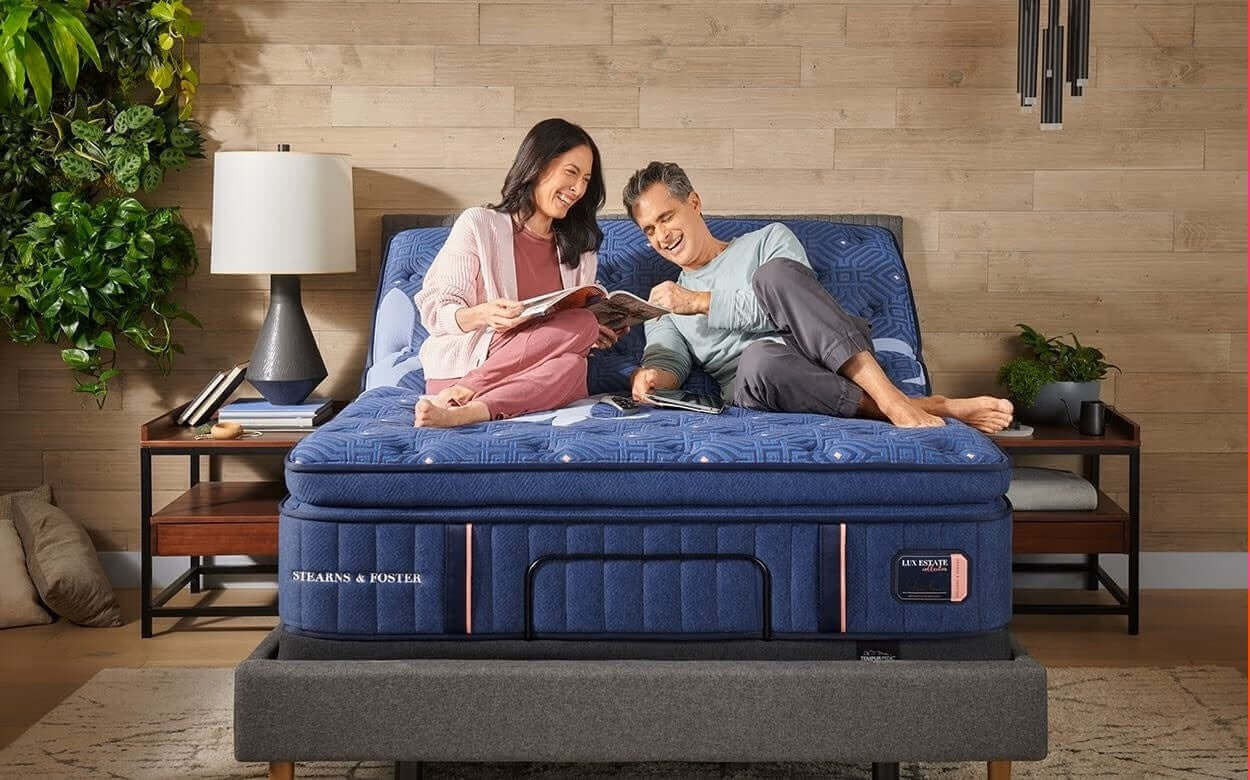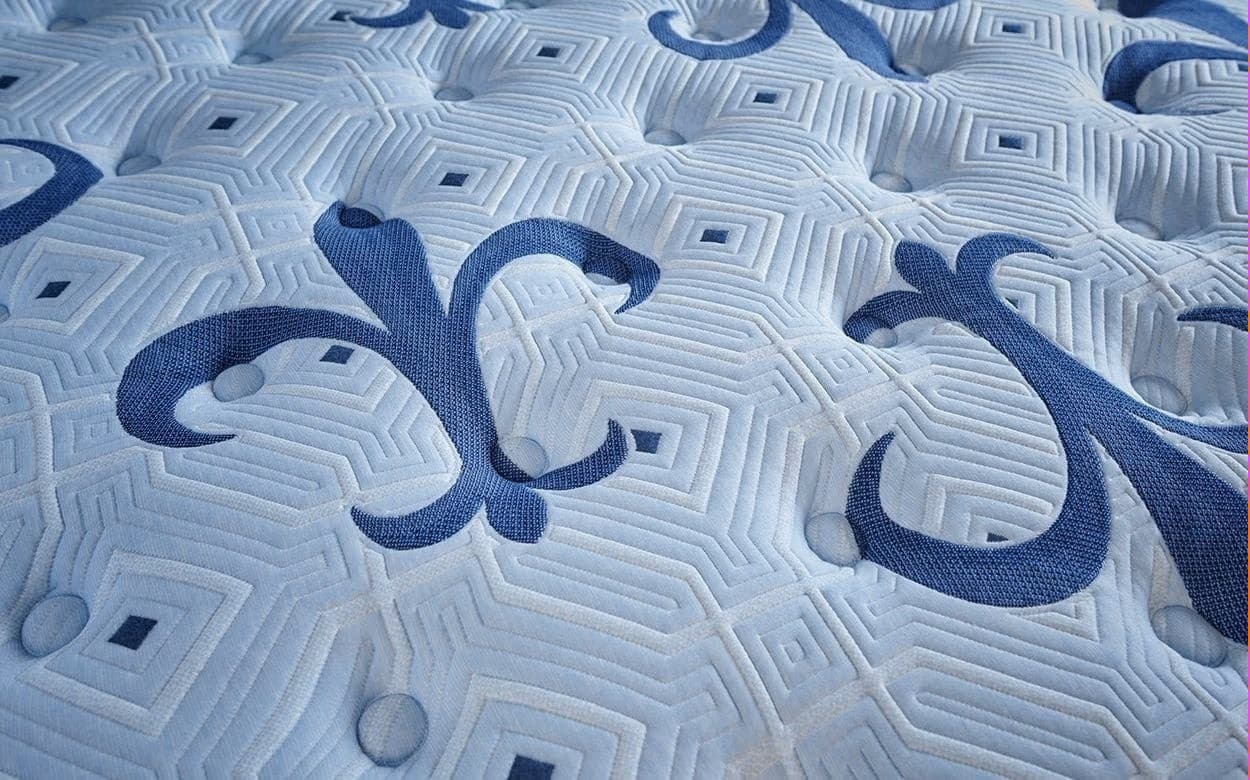Heavy mattresses such as dense memory foam, natural latex, or high-fill hybrid models are increasingly popular because they offer pressure relief, durability, and deep contouring.
But their extra weight changes the rules for what a supportive bed frame must provide. A flimsy or improperly designed frame can sag, creak, or fail early. This guide breaks down what matters most when you’re pairing a heavy mattress with a frame so you can sleep confidently, prolong mattress life, and protect your investment.
Table of Contents
- Introduction
- Key Takeaways
- What Counts as a “Heavy Mattress”?
- Why Frame Choice Matters
- Core Features to Look For
- Comparison Table
- Visual Graph
- How to Measure for a New Frame
- Best Frame Designs by Mattress Type
- Product Reviews
- Setup, Maintenance, and Longevity Tips
- Budget Considerations
- Conclusion
- FAQs
Key Takeaways
- Heavy mattresses (typically 80+ lbs for queen and 100+ lbs for king) need rigid frames with close slat spacing, a center support rail, and a weight rating that exceeds combined mattress + sleeper weight.
- Best frame materials: steel or solid hardwood (maple, oak) for durability; avoid thin plywood and weak particleboard.
- Look for slats ≤3" spacing (or metal platform with no spacing), reinforced center posts, and steel brackets/fasteners.
- Adjustable bases and storage frames are compatible if they’re rated for the mattress weight and have a stable platform.
- Consider bed height, box-spring vs. platform compatibility, and warranty when buying.
What Counts as a “Heavy Mattress”?
There’s no single industry definition, but practical thresholds help:
- Twin/Full: >40–60 lb
- Queen: >70–90 lb
- King: >90–120+ lb
Heavy mattresses are often high-density memory foam, latex, multi-layer hybrids, or pillow-top innerspring designs. Also factor in combined sleeper weight: a heavy mattress plus two heavy sleepers increases the load the frame must carry.
Why Frame Choice Matters
A bed frame is not just aesthetics; it’s structural support, ventilation, and the first line of defense against sagging. The wrong frame can void mattress warranties or cause uneven wear. For heavy mattresses, the frame must:
- Distribute weight evenly across the surface
- Prevent mid-center sag by offering robust middle support
- Resist deformation (no bowed slats or weak joints)
- Offer stable connections for headboards and accessories.
Core Features to Look For
Material & Build
- Steel frames: Excellent load capacity and long-term durability. Look for thick steel gauge and welded joints rather than thin bolt-together tubes.
- Solid hardwood: Maple, oak, or ash frames offer rigidity and a premium look. Avoid low-grade plywood or particleboard.
- Hybrid frames (wood + metal): Can offer the best of both worlds if engineered well.
Slat Type and Spacing
- Solid plywood or slats: Wide slats with a continuous platform are ideal
- Slat spacing: Aim for ≤3 inches between slats for memory foam and latex some manufacturers recommend ≤2.75". Wider spacing risks mattress sag and warranty issues.
- Steel platform: A perforated/mesh steel deck gives consistent support and is great for heavy mattresses.
Center Support and Legs
- Center rail: Mandatory for queen/king heavy mattresses. Single center supports are not enough; prefer crossbars or multiple center legs spaced evenly.
- Legs: Reinforced legs (prefer metal with welded plates) and a minimum of 3-5 center legs for king/California king sizes.
Weight Rating & Warranty
- Confirm the frame weight rating: it should exceed the combined weight (mattress + sleepers + bedding) with margin. If you plan for 700 lb total, get a frame rated for ≥900 lb to be safe.
- Strong warranty (5+ years) indicates manufacturer confidence.
Compatibility
- Adjustable bases: If you use an adjustable base, use a compatible frame or a frame designed to house the base with clearance and secure anchoring.
- Storage: Platform frames with drawers are great but require reinforced bottoms; check storage base weight specs.
Comparison Table
|
Frame Type |
Best For |
Slat/Platform |
Durability |
Typical Weight Rating |
Notes |
|
Steel Platform (solid deck) |
Heavy latex/hybrid |
Solid metal deck or closely perforated |
Very High |
800–1500+ lb |
Excellent for heavy mattresses |
|
Solid Hardwood Platform |
Heavy memory foam, latex |
Wide boards or plywood top |
High |
600–1200 lb |
Premium look; heavier & pricier |
|
Metal Slat Frame |
Budget heavy-duty |
Metal slats ≤3" spacing |
High (if thick gauge) |
600–1000 lb |
Look for welded joints |
|
Box-spring + Frame |
Traditional innerspring |
Depends on box-spring |
Medium |
Varies widely |
Not ideal for dense foam/top layers |
|
Adjustable Base (with frame) |
Adjustable-friendly heavy mattresses |
Solid platform or base-specific |
High (if rated) |
600–1500 lb |
Use manufacturer recommendations |
Visual Graph

How to Measure for a New Frame
1. Measure mattress dimensions (length x width x thickness).
2. Add clearance for headboard/footboard brackets or adjustable bases.
3. Check slat-to-slat spacing and center rail position (measure from slat center to slat center).
4. Calculate total load = mattress weight + estimated sleepers’ weight + storage + topper; choose a frame rated 20–30% higher.
5. Measure room entry points many heavy-duty frames are heavy and may require assembly inside the room.
Best Frame Designs by Mattress Type
Memory Foam
- Needs a flat, stable surface with slat spacing ≤3".
- Platform or solid deck frames preferred.
- Metal platforms with perforations are excellent for airflow.
Hybrid
- High coil counts plus foam layers are heavy; choose frames with strong center support and slat reinforcement.
- Avoid very wide slat spacing; open designs with center rails work well.
Latex
- Dense, very heavy requires the strongest frames (steel deck or solid hardwood with plywood top).
- Enhanced airflow is crucial to mitigate heat retention.
Innerspring / Pillowtop
- Heavy pillowtops benefit from rigid platforms or a robust box-spring + frame combination if the manufacturer recommends it.
Product Review Section
1. Queen – Knickerbocker Ultima Standard Metal 4-in-1 Bed Frame
Overview:
The Knickerbocker Ultima is a versatile, heavy-duty metal bed frame built from high-carbon steel with a dual-beam center support system. It’s marketed as a “4-in-1” frame (i.e. able to adapt to multiple bed types/sizes) and supports headboard mounting. It comes with a lifetime warranty (with proof of purchase).
Key Features:
- Constructed from high-carbon rail-track steel and heavy-duty angle iron
- Dual-beam center support for extra middle rigidity across all sizes
- Pedestal-style legs and “deluxe rug rollers” for mobility and stability.
- Universal compatibility (Twin up to King, headboard-friendly)
- Lifetime warranty with proof of purchase.
Pros & Cons:
|
Pros |
Cons |
|
Strong steel construction with central reinforcement. |
Metal finish may be prone to scratches or rust in humid environments. |
|
Lifetime warranty (with proof) offers long-term peace of mind. |
No user reviews currently, so long-term real-world durability is unverified. |
|
Universal sizing and easy headboard attachment. |
Rug rollers may cause slight movement over time unless secured. |
|
Dual-beam support helps prevent sagging for heavier mattresses. |
Appearance is utilitarian rather than decorative; may require a headboard or skirt for aesthetics. |
2. Framos Full/Queen/Twin Adjustable Frame
Overview:
The Framos Adjustable Frame is a metal bed base designed to flexibly accommodate Full, Queen, and Twin mattress sizes. It features a sturdy high-carbon steel build and solid rivet construction, with a central support leg and casters for mobility all in a lightweight package (24 lbs) that balances flexibility and strength.
Key Features:
- Adjustable width to fit Full, Queen, and Twin mattress sizes
- Constructed of high-carbon rail steel with solid rivet joints for durability.
- Heavy-duty headboard brackets included for secure attachment.
- Extra center leg for additional support and stability.
- Equipped with four casters (wheels) for easier movement and repositioning.
Pros & Cons:
|
Pros |
Cons |
|
Adjustable to three mattress sizes (Full / Queen / Twin. |
Lightweight frame (24 lbs) might limit heavy-load capacity. |
|
Durable steel + rivet construction. |
Casters may cause some shifting unless locked or secured. |
|
Center support leg improves stability. |
No published high load rating; may be less ideal for very heavy mattresses. |
|
Headboard mounting brackets included. |
May require extra reinforcement for very dense or extra-thick mattresses. |
Setup, Maintenance, and Longevity Tips
- Tighten bolts at 30-day intervals for the first 6 months then annually.
- Check slats for bending; replace if bowed.
- Protect finishes on wood frames from moisture.
- Use furniture lifts or extra center legs if you notice early sagging.
- Avoid jumping on heavy mattresses to reduce stress on the frame.
Budget Considerations
- Expect to pay more for steel welded platforms and solid hardwood.
- A reliable mid-range frame for heavy mattresses runs roughly in the middle prioritize weight rating and center support over decorative extras.
- Don’t skimp: a cheap frame may save money up front but shorten mattress life.
Conclusion
For heavy mattresses, prioritize support, not style. A steel platform or solid hardwood frame with a solid deck or slats spaced at ≤3" and a reinforced center support will keep a heavy mattress performing well for years.
If you sleep hot, favor frames with perforated decks or open slats to aid airflow. For adjustable setups, ensure compatibility and confirm weight ratings. Match your choice to mattress type: dense latex needs the sturdiest frames; memory foam needs consistent, closely spaced slats; hybrids need both airflow and center reinforcement.
Best for heavy latex/hybrid: welded steel platform or solid hardwood with plywood deck.
Best for memory foam: platform with closely spaced slats or solid perforated deck.
Best budget option: metal frames with thick slats and additional center legs check the weight rating closely.
FAQs
1. Do heavy mattresses need a box spring?
Not usually. Most heavy memory-foam and latex mattresses are designed for platform beds or solid decks. Check the mattress manufacturer’s warranty; some older innersprings may still recommend a box-spring.
2. How much weight should a bed frame support?
Add mattress weight + sleepers’ combined weight + bedding + storage. Choose a frame rated at least 20–30% higher than your total to be safe.
3. Can I use an adjustable base with a heavy mattress?
Yes if the adjustable base and the frame are rated to handle the mattress weight. Many adjustable bases are rated for heavy hybrids and latex always verify manufacturer specs.
4. What slat spacing is ideal for heavy foam mattresses?
Aim for slat spacing of 3 inches or less; many manufacturers recommend 2.5–3 inches for warranty compliance.
5. Is steel or wood better for heavy mattresses?
Both can work. Steel typically offers higher weight ratings for less bulk; solid hardwood offers aesthetics and strong support if well-constructed.
6. How many center legs does a king-size frame need?
Preferably multiple center legs (3–5) across the length of the center support rail to evenly distribute weight and reduce sag.
7. My frame creaks is it unsafe?
Creaking is often a sign of loose hardware or minor movement. Tighten bolts. If structural components are bent or cracked, replace parts or the frame.
8. Will a platform bed reduce mattress wear?
Yes uniform support reduces sagging and keeps the mattress layers working as intended, prolonging lifespan.
9. Can I retrofit my existing frame for a heavy mattress?
Yes add a bunkie board, plywood sheet, or extra center legs, but confirm weight rating and ensure the retrofit doesn’t void warranties.
10. What about bed height and accessibility?
Thicker mattresses on tall frames can be hard to climb into. Consider frame + mattress height for ease of use many people aim for a combined sleep surface height between 24–28 inches.


